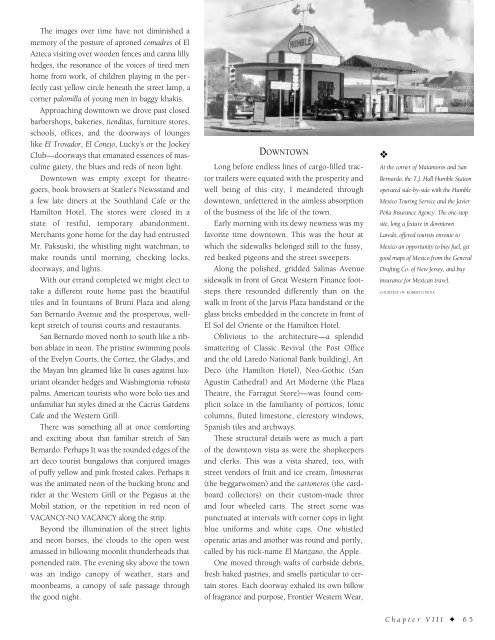Historic Laredo
An illustrated history of the city of Laredo and the Webb County area, paired with the histories of companies, families and organizations that make the region great.
An illustrated history of the city of Laredo and the Webb County area, paired with the histories of companies, families and organizations that make the region great.
Create successful ePaper yourself
Turn your PDF publications into a flip-book with our unique Google optimized e-Paper software.
The images over time have not diminished a<br />
memory of the posture of aproned comadres of El<br />
Azteca visiting over wooden fences and canna lilly<br />
hedges, the resonance of the voices of tired men<br />
home from work, of children playing in the perfectly<br />
cast yellow circle beneath the street lamp, a<br />
corner palomilla of young men in baggy khakis.<br />
Approaching downtown we drove past closed<br />
barbershops, bakeries, tienditas, furniture stores,<br />
schools, offices, and the doorways of lounges<br />
like El Trovador, El Conejo, Lucky’s or the Jockey<br />
Club—doorways that emanated essences of masculine<br />
gaiety, the blues and reds of neon light.<br />
Downtown was empty except for theatregoers,<br />
book browsers at Statler’s Newsstand and<br />
a few late diners at the Southland Cafe or the<br />
Hamilton Hotel. The stores were closed in a<br />
state of restful, temporary abandonment.<br />
Merchants gone home for the day had entrusted<br />
Mr. Paksuski, the whistling night watchman, to<br />
make rounds until morning, checking locks,<br />
doorways, and lights.<br />
With our errand completed we might elect to<br />
take a different route home past the beautiful<br />
tiles and lit fountains of Bruni Plaza and along<br />
San Bernardo Avenue and the prosperous, wellkept<br />
stretch of tourist courts and restaurants.<br />
San Bernardo moved north to south like a ribbon<br />
ablaze in neon. The pristine swimming pools<br />
of the Evelyn Courts, the Cortez, the Gladys, and<br />
the Mayan Inn gleamed like lit oases against luxuriant<br />
oleander hedges and Washingtonia robusta<br />
palms. American tourists who wore bolo ties and<br />
unfamiliar hat styles dined at the Cactus Gardens<br />
Cafe and the Western Grill.<br />
There was something all at once comforting<br />
and exciting about that familiar stretch of San<br />
Bernardo. Perhaps It was the rounded edges of the<br />
art deco tourist bungalows that conjured images<br />
of puffy yellow and pink frosted cakes. Perhaps it<br />
was the animated neon of the bucking bronc and<br />
rider at the Western Grill or the Pegasus at the<br />
Mobil station, or the repetition in red neon of<br />
VACANCY-NO VACANCY along the strip.<br />
Beyond the illumination of the street lights<br />
and neon horses, the clouds to the open west<br />
amassed in billowing moonlit thunderheads that<br />
portended rain. The evening sky above the town<br />
was an indigo canopy of weather, stars and<br />
moonbeams, a canopy of safe passage through<br />
the good night.<br />
DOWNTOWN<br />
Long before endless lines of cargo-filled tractor<br />
trailers were equated with the prosperity and<br />
well being of this city, I meandered through<br />
downtown, unfettered in the aimless absorption<br />
of the business of the life of the town.<br />
Early morning with its dewy newness was my<br />
favorite time downtown. This was the hour at<br />
which the sidewalks belonged still to the fussy,<br />
red beaked pigeons and the street sweepers.<br />
Along the polished, gridded Salinas Avenue<br />
sidewalk in front of Great Western Finance footsteps<br />
there resounded differently than on the<br />
walk in front of the Jarvis Plaza bandstand or the<br />
glass bricks embedded in the concrete in front of<br />
El Sol del Oriente or the Hamilton Hotel.<br />
Oblivious to the architecture—a splendid<br />
smattering of Classic Revival (the Post Office<br />
and the old <strong>Laredo</strong> National Bank building), Art<br />
Deco (the Hamilton Hotel), Neo-Gothic (San<br />
Agustín Cathedral) and Art Moderne (the Plaza<br />
Theatre, the Farragut Store)—was found complicit<br />
solace in the familiarity of porticos, Ionic<br />
columns, fluted limestone, clerestory windows,<br />
Spanish tiles and archways.<br />
These structural details were as much a part<br />
of the downtown vista as were the shopkeepers<br />
and clerks. This was a vista shared, too, with<br />
street vendors of fruit and ice cream, limosneras<br />
(the beggarwomen) and the cartoneros (the cardboard<br />
collectors) on their custom-made three<br />
and four wheeled carts. The street scene was<br />
punctuated at intervals with corner cops in light<br />
blue uniforms and white caps. One whistled<br />
operatic arias and another was round and portly,<br />
called by his nick-name El Manzano, the Apple.<br />
One moved through wafts of curbside debris,<br />
fresh baked pastries, and smells particular to certain<br />
stores. Each doorway exhaled its own billow<br />
of fragrance and purpose, Frontier Western Wear,<br />
❖<br />
At the corner of Matamoros and San<br />
Bernardo, the T.J. Hall Humble Station<br />
operated side-by-side with the Humble<br />
Mexico Touring Service and the Javier<br />
Peña Insurance Agency. The one-stop<br />
site, long a fixture in downtown<br />
<strong>Laredo</strong>, offered tourists enroute to<br />
Mexico an opportunity to buy fuel, get<br />
good maps of Mexico from the General<br />
Drafting Co. of New Jersey, and buy<br />
insurance for Mexican travel.<br />
COURTESY OF ROBERTO PEÑA<br />
Chapter VIII ✦ 65
















